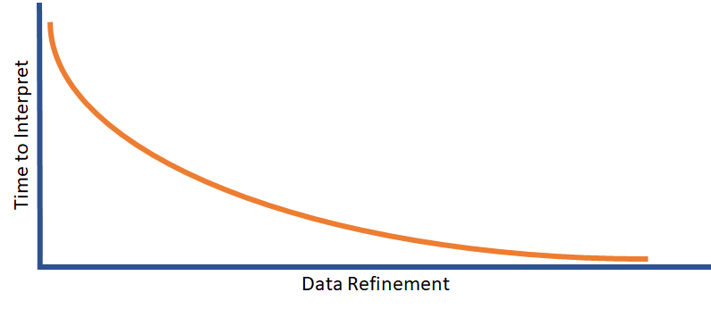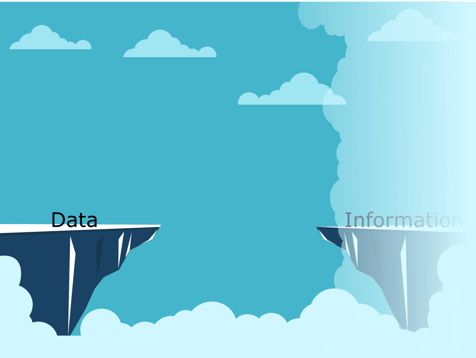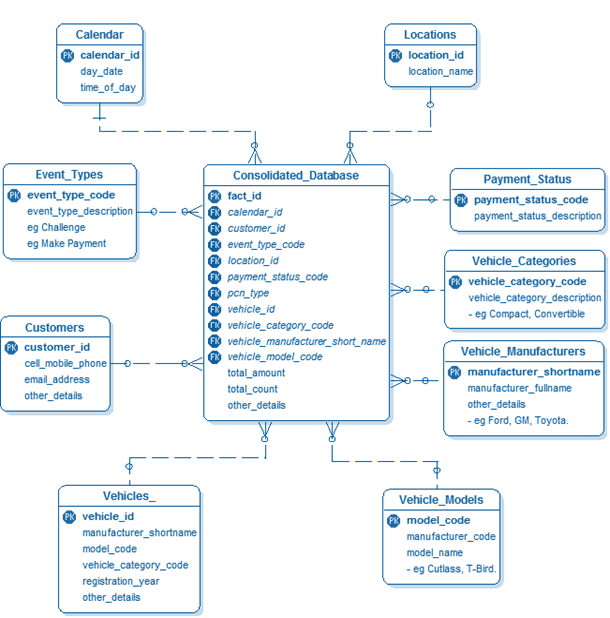The entire process of turning data into information is what Data Warehousing, Data Governance, Analytics, Data Science, and Data Integration is all about. But what exactly is information? What really differentiates data from information? Not surprisingly the word information can be broken up as "in" and "formation". The ability to organize noise is at the heart of information. Data is nothing more than a raw material in need of formation. Information represents refinement and readiness for consumption. From a business stakeholder's perspective, information means easily consumable insight for decision-making. Perhaps that is the ultimate scale of what represents information. How long does it take to consume for accurate decisions? Raw data would be at one end of the scale and Information would be at the other end.

When does the orange data line become "information?" Looking at this graph, it would seem that an arbitrary vertical dotted line could be placed somewhere on the Data Refinement scale. However, the truth is that the definition of Information has some nuance when it comes to the data-to-information factory. This is because we want the organization to behave like a superorganism towards a unified goal. Doing that requires consensus of what "truth" represents to that superorganism. Defining that consensus is what enables organizations to project the "Data Refinement" end state.  Not surprisingly this will require business stakeholders to participate in interviews that are meticulously documented to define what "information" is.
Not surprisingly this will require business stakeholders to participate in interviews that are meticulously documented to define what "information" is.
Some attempt to derive what information is by "letting the data tell you" what it is. This is a great way of driving your data-to-information process into the ditch. Turns out, people really care about what information means to them and how they want it portrayed. To get the organization to internalize the consensus of truth and behave like a superorganism, the business and technical stakeholders need to define it and own it.
These interviews reveal what the organization wants the reusable building blocks of information to be. But to turn that consensus into a reality where actual data gets delivered based on it, a more concrete version of that consensus must be built which can be operationalized later. Enter the Conceptual Data Model.

A data model is a schematic expression of the analytical requirements from the business and technical stakeholders. This expression applies some specific rules for how to logically define the requirements. There are multiple types of modeling, but one of the most fundamental is something called a Kimball Model. There are entire books on this topic, but here are two of the high-level points:
- The dimensions of data that were documented in earlier strategy sessions are represented as surrounding tables with their available columns of data listed.
- The measures are centrally housed in a table called the Fact Table and connected to the dimensions through a relationship called a Foreign Key.
Intricity creates these models in specialized tools that can produce database code to generate a physical schema. This schema will, in the future, house data. What this means is that the data model is a physical expression of the building blocks which the business and technical stakeholders consider "informational". Just like most things, the first iteration of a data model is not the final iteration. A data model will undergo many transformations as it gets validation by the business stakeholders. Often that process is as simple as putting the data model on the projector and working collectively to break it by asking questions that it can't answer. These actions further refine and harden the model's capacity to represent the organization's definition of "information".
For the purposes of a Data Strategy, Intricity scopes the data modeling to just the initial conceptual model. This allows a natural break for the organization to allocate the required budgets to proceed with the vetting and ultimately the development activities for conforming their data into the new informational target model. Those activities take us to one of Intricity's core pillars and capabilities: Accelerate.
Who is Intricity?
Intricity is a specialized selection of over 100 Data Management Professionals, with offices located across the USA and Headquarters in New York City. Our team of experts has implemented in a variety of Industries including, Healthcare, Insurance, Manufacturing, Financial Services, Media, Pharmaceutical, Retail, and others. Intricity is uniquely positioned as a partner to the business that deeply understands what makes the data tick. This joint knowledge and acumen has positioned Intricity to beat out its Big 4 competitors time and time again. Intricity’s area of expertise spans the entirety of the information lifecycle. This means when you’re problem involves data; Intricity will be a trusted partner. Intricity's services cover a broad range of data-to-information engineering needs:
What Makes Intricity Different?
While Intricity conducts highly intricate and complex data management projects, Intricity is first a foremost a Business User Centric consulting company. Our internal slogan is to Simplify Complexity. This means that we take complex data management challenges and not only make them understandable to the business but also make them easier to operate. Intricity does this through using tools and techniques that are familiar to business people but adapted for IT content.
Thought Leadership
Intricity authors a highly sought after Data Management Video Series targeted towards Business Stakeholders at https://www.intricity.com/videos. These videos are used in universities across the world. Here is a small set of universities leveraging Intricity’s videos as a teaching tool:

Talk With a Specialist
If you would like to talk with an Intricity Specialist about your particular scenario, don’t hesitate to reach out to us. You can write us an email: specialist@intricity.com
(C) 2023 by Intricity, LLC
This content is the sole property of Intricity LLC. No reproduction can be made without Intricity's explicit consent.
Intricity, LLC. 244 Fifth Avenue Suite 2026 New York, NY 10001
Phone: 212.461.1100 • Fax: 212.461.1110 • Website: www.intricity.com


